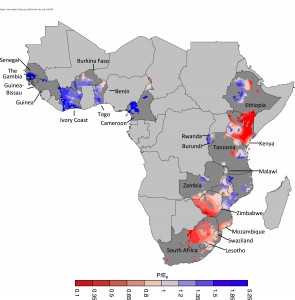By Molly Sharlach, Office of the Dean for Research

Today’s food production relies heavily on irrigation, but across sub-Saharan Africa only 4 percent of cultivated land is irrigated, compared with a global average of 18 percent. Small-scale farming is the main livelihood for many people in the region, who depend on rainfall to water their crops.
To understand how climate change may affect the availability of water for agriculture, researchers at Princeton University analyzed trends in the water cycle in maize-growing areas of 21 African countries between 1979 and 2010. The team examined both levels of rainfall and the evaporative demand of the atmosphere — the combined effects of evaporation and transpiration, which is the movement of water through plants.
Overall, they found increases in water availability during the maize-growing season, although the trends varied by region. The greater availability of water generally resulted from a mixture of increased rainfall and decreased evaporative demand.
However, some regions of East Africa experienced declines in water availability, the study found. “Some places, like parts of Tanzania, got a double whammy that looks like a declining trend in rainfall as well as an increasing evaporative demand during the more sensitive middle part of the growing season,” said Lyndon Estes, the study’s lead author and an associate research scholar in the Program in Science, Technology and Environmental Policy at the Woodrow Wilson School of Public and International Affairs. The analysis was published in the July issue of the journal Environmental Research Letters.
A key goal of the study was to incorporate reliable data on factors that influence evaporative demand. These include temperature, wind speed, humidity and net radiation — defined as the amount of energy from the sun that is absorbed by the land, minus the amount reflected back into the atmosphere by the Earth’s surface. Measurements of three of these parameters came from the Princeton University Global Meteorological Forcing Dataset (PGF) previously developed by two of the study’s authors, Research Scholar Justin Sheffield and Eric Wood, the Susan Dod Brown Professor of Civil and Environmental Engineering and the study’s senior author.
The PGF merges a variety of weather and satellite data, and covers all land areas at a resolution of three hours and one degree of latitude or longitude (one degree of latitude is about 70 miles). Nathaniel Chaney, a graduate student who works with Sheffield, downscaled the data to a resolution of about 15 miles. He incorporated observations from African weather stations to improve the accuracy of the data. To do this, he used statistical techniques based on the principle that areas close to one another are likely to have similar weather.
The team also had to correct the data for errors due to changes in instruments or satellites, which can create what appear to be sudden jumps in temperature or wind speed. “When you’re dealing with gridded global weather data, they come with many warts,” Estes said. “So we try to remove as many of those warts as possible,” he said, to gain a faithful picture of weather changes at each location.
Most areas saw a decrease in evaporative demand, leading to higher water availability. The researchers analyzed the contributions of different factors to this decrease, and found that a downward trend in net radiation was largely responsible for the change. This was a surprising result, according to Estes, who said he expected to see decreases in evaporative demand, but thought lower wind speeds would have a greater impact than drops in net radiation. In a 2012 study published in the journal Nature, Sheffield and Wood showed that diminished wind speeds have helped to offset the effects of rising temperatures that would otherwise lead to an increase in droughts. Another study found that decreasing wind speeds contributed to declining evaporative demand in South Africa. The current study only examined water availability during the maize growing season, which could account for this discrepancy, Estes said.
The trends revealed by this research could have implications for agricultural policies and practices, including irrigation planning, timing of planting and choice of crop varietals. For example, in Burkina Faso in West Africa, a comparison of different parts of the growing season showed a decrease in water availability early in the season, but an increase at later time points. This might mean that the rainy season is starting later, in which case farmers in that region might adapt by planting their maize later. In South Africa, evaporative demand dropped in many areas; this could inform a reallocation of water use.
According to Estes, this study, which examined only 34 percent of all African maize-growing areas, may serve as a framework to guide more detailed analyses within individual countries. It’s also essential to understand the relationship between changes in water availability and changes in actual crop yields, which is more complex because yield trends are influenced by numerous political and economic factors, in addition to farming practices. That’s where Estes hopes to focus his next efforts. “All those factors would have to be teased out to isolate what these changes in water supply and demand mean for crop production,” he said.
Other researchers in Princeton’s Department of Civil and Environmental Engineering involved in the study include graduate student Julio Herrera Estrada and Associate Professor Kelly Caylor.
This work was funded by the United States Army Corps of Engineers Institute for Water Resources, the NASA Measures Program and the Princeton Environmental Institute Grand Challenges Program.
Estes, L. D.; Chaney, N. W.; Herrera-Estrada, J.; Sheffield, J.; Caylor, K. K.; Wood, E. F. Changing water availability during the African maize-growing season, 1979–2010. Environmental Research Letters Volume 9 Number 7 075005 doi:10.1088/1748-9326/9/7/075005

You must be logged in to post a comment.